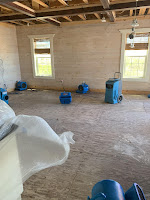Inspecting your freshly replaced roof is a vital step in ensuring a job well done! 🏠 Here’s a comprehensive guide to help you navigate the post-roof replacement inspection process: 1. Visual Assessment: Take a close look at your roof’s surface. 🧐 Check for any visible signs of damage, such as dents, scratches, or misaligned shingles. Proper alignment is key to a durable and aesthetically pleasing roof. 2. Shingle Inspection: Examine each shingle individually. Ensure they are securely fastened and show no signs of curling or lifting. A well-installed roof should have uniformly placed and firmly attached shingles. 🏡 3. Flashing Around Chimneys and Vents: Check the flashing around chimneys and vents. It’s essential for these areas to have a watertight seal. Any gaps or loose flashing could lead to leaks. 🚫💧 4. Gutter and Downspout Examination: Assess the condition of your gutters and downspouts. Make sure they are clear of debris and properly attached to your roof. Ad...
FOR EMERGENCY WATER EXTRACTION FILL OUT FORM OR CALL; 859-314-6093 To reach A Water Damage Pro

Looking for reliable and trustworthy professionals to help restore your home or business after water or fire damage? Look no further than Property Damage Solutions LLC! Our family-owned and operated business has been serving Central Kentucky for years, and we pride ourselves on providing top-notch restoration services. Our team of experts is IICRC certified, meaning that they have the knowledge and training necessary to handle any restoration project. 8593029666 or 8593146093




Comments
Post a Comment
Hire Property Damage Solutions Water Damage Restoration Contractors in Richmond, KY. We Offer Affordable Water Damage Restoration Cost for Commercial Water Damage Restoration and Residential Water Damage Restoration in Richmond, KY.
Water Damage can be a devastating event. It can happen to anyone at any time. Water damage can occur as the result of many different things such as a broken pipe, a flood, or even a natural disaster. Regardless of how your water damage occurs, it is important to take care of the Water Damage Restoration Problem as soon as possible. Not only will this help minimize the amount of damage that is done, but it will also help keep mold and mildew from growing. Our Team of Water Damage Restoration Technicians is standing by 24/7 to help you get your life back on track. ☎️ Call 859-302-9666
Water Damage Restoration Richmond - Kentucky
Water Damage Restoration Service in Richmond, KY
Water damage can be a huge headache. Not only does it cause massive destruction, but it can also lead to serious health problems if not treated quickly and properly. Water damage can come from any number of sources a broken pipe, a natural disaster, faulty plumbing, etc. And left untreated, water damage can rapidly become a bigger and bigger problem. Our team of Professional Water Damage Restoration Contractors is highly trained to handle any size job quickly and efficiently. We will work tirelessly to get your home or business back to its original condition as quickly as possible.
Commercial Water Damage Restoration in Richmond, KY
Water damage can be a huge problem for businesses, and it is often difficult to find a reliable and Experienced Water Damage Restoration Company that can provide quality commercial water damage restoration services. Not only is water damage a huge inconvenience, but it can also be incredibly costly to repair. Businesses need a reliable and experienced company that they can trust to provide Commercial Restoration Services. We are a professional commercial water damage restoration company with years of experience in the industry. We provide Best Water Damage Restoration Services in Richmond, KY, and we always put our customers first. Contact us today for more information about our services.
Water Damage Restoration Near Me in Richmond, KY
Water damage can happen to anyone at any time. You might be dealing with a broken pipe, a flood, or even just a little water on the floor. No matter what the cause of your water damage is, its important to take care of the problem as soon as possible. Left untreated, water damage can quickly become worse and lead to extensive repairs. We are here to help you. Our Emergency Water Damage Restoration Services from PDS are available 24/7, and we have fully trained technicians who can take care of everything for you. We will work quickly to get your home or business back to normal.
Water Damage Restoration Near Me in Richmond, KY
Best Water Damage Restoration in Richmond, KY
Water damage can be a huge hassle. It can cause a lot of damage in a short period of time, and the cleanup process is often long and arduous. Not only is water damage costly to repair, but it can also cause health problems if not cleaned up properly. Our Team of Water Damage Restoration Experts offers the best water damage restoration in Richmond, KY. We are available 24/7 for emergency services and our cost is very affordable. We provide commercial water damage restoration, Home Water Damage Restoration, and emergency water damage restoration services in Richmond, KY. Call us at (859)302-9666 for more information about our Best Water Damage Restoration services.
Lexington, KY